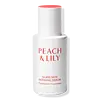What's inside
What's inside
 Key Ingredients
Key Ingredients

 Benefits
Benefits

 Concerns
Concerns

 Ingredients Side-by-side
Ingredients Side-by-side

Water
Skin ConditioningButylene Glycol
HumectantHydroxyethyl Urea
HumectantPPG-10 Methyl Glucose Ether
Skin ConditioningPentylene Glycol
Skin ConditioningDipropylene Glycol
HumectantDiglycerin
HumectantTriethyl Citrate
MaskingPEG-32
HumectantUrea
BufferingCarbomer
Emulsion StabilisingPhenoxyethanol
PreservativePEG-75
HumectantGlycosyl Trehalose
Emulsion StabilisingDisodium Succinate
MaskingSodium Hyaluronate
HumectantHydrogenated Starch Hydrolysate
HumectantSorbitol
HumectantDiethoxyethyl Succinate
SolventHexylglycerin
HumectantPotassium Hydroxide
BufferingPolyquaternium-51
Skin ConditioningSuccinic Acid
BufferingDisodium EDTA
Hydroxyethylcellulose
Emulsion StabilisingXanthan Gum
EmulsifyingHydrolyzed Hyaluronic Acid
HumectantSodium Acetylated Hyaluronate
HumectantHydrolyzed Sodium Hyaluronate
Skin ConditioningEthylhexyl Stearate
EmollientLactococcus/Hyaluronic Acid Ferment Filtrate
Hydroxypropyltrimonium Hyaluronate
Sodium Hyaluronate Crosspolymer
HumectantPolyglyceryl-4 Diisostearate/Polyhydroxystearate/Sebacate
EmulsifyingSodium Isostearate
CleansingWater, Butylene Glycol, Hydroxyethyl Urea, PPG-10 Methyl Glucose Ether, Pentylene Glycol, Dipropylene Glycol, Diglycerin, Triethyl Citrate, PEG-32, Urea, Carbomer, Phenoxyethanol, PEG-75, Glycosyl Trehalose, Disodium Succinate, Sodium Hyaluronate, Hydrogenated Starch Hydrolysate, Sorbitol, Diethoxyethyl Succinate, Hexylglycerin, Potassium Hydroxide, Polyquaternium-51, Succinic Acid, Disodium EDTA, Hydroxyethylcellulose, Xanthan Gum, Hydrolyzed Hyaluronic Acid, Sodium Acetylated Hyaluronate, Hydrolyzed Sodium Hyaluronate, Ethylhexyl Stearate, Lactococcus/Hyaluronic Acid Ferment Filtrate, Hydroxypropyltrimonium Hyaluronate, Sodium Hyaluronate Crosspolymer, Polyglyceryl-4 Diisostearate/Polyhydroxystearate/Sebacate, Sodium Isostearate
Water
Skin ConditioningPropanediol
SolventButylene Glycol
HumectantNiacinamide
Smoothing1,2-Hexanediol
Skin ConditioningPrunus Persica Fruit Extract
AbrasiveDioscorea Japonica Root Extract
Skin ConditioningSodium Hyaluronate
HumectantAdenosine
Skin ConditioningHydrolyzed Sodium Hyaluronate
Skin ConditioningMadecassoside
AntioxidantHydrolyzed Hyaluronic Acid
HumectantSodium Acetylated Hyaluronate
HumectantAcetyl Octapeptide-3
HumectantEthylhexylglycerin
Skin ConditioningHydrolyzed Corn Starch
HumectantSodium Carbomer
Emulsion StabilisingBeta-Glucan
Skin ConditioningSaccharide Isomerate
HumectantPhytic Acid
Sucrose
HumectantAsiaticoside
AntioxidantCaprylyl Glycol
EmollientWater, Propanediol, Butylene Glycol, Niacinamide, 1,2-Hexanediol, Prunus Persica Fruit Extract, Dioscorea Japonica Root Extract, Sodium Hyaluronate, Adenosine, Hydrolyzed Sodium Hyaluronate, Madecassoside, Hydrolyzed Hyaluronic Acid, Sodium Acetylated Hyaluronate, Acetyl Octapeptide-3, Ethylhexylglycerin, Hydrolyzed Corn Starch, Sodium Carbomer, Beta-Glucan, Saccharide Isomerate, Phytic Acid, Sucrose, Asiaticoside, Caprylyl Glycol
 Reviews
Reviews

Ingredients Explained
These ingredients are found in both products.
Ingredients higher up in an ingredient list are typically present in a larger amount.
Butylene Glycol (or BG) is used within cosmetic products for a few different reasons:
Overall, Butylene Glycol is a safe and well-rounded ingredient that works well with other ingredients.
Though this ingredient works well with most skin types, some people with sensitive skin may experience a reaction such as allergic rashes, closed comedones, or itchiness.
Learn more about Butylene GlycolHydrolyzed Hyaluronic Acid is a form of hyaluronic acid. It is created by the hydrolysis of hyaluronic acid with a high molecular weight. Once created, Hydrolyzed Hyaluronic Acid has a low molecular weight.
Low molecular weight HA has been shown to hydrate and increase elasticity of the skin. Increasing elasticity is also associated with reduction of wrinkle depth.
One study found topical low molecular weight hyaluronic acid may be considered for the treatment of rosacea in the adult population. However, we always recommend speaking with a professional about your skin concerns.
Hyaluronic acids are a humectant. This means they draw moisture from the air. Hyaluronic acids help moisturize, soothe, and protect the skin.
Read more about other common forms of hyaluronic acid:
Learn more about Hydrolyzed Hyaluronic AcidThis ingredient is created by putting sodium hyaluronate through hydrolysis.
You might know this as 'mini' or 'ultra low-molecular weight' hyaluronic acid. The small molecule size means it is able to travel deeper in the skin.
According to studies, low molecular-weight hyaluronic acid can:
One study from 2011 found ultra-low weight HA to show pro-inflammatory properties. Another study from 2022 found it to downregulate UV-B induced inflammation.
Hydrolysis is a process of changing a molecule using water or enzymes.
This ingredient is water-soluble.
Learn more about Hydrolyzed Sodium HyaluronateSodium Acetylated Hyaluronate is a type of Hyaluronic Acid.
Hyaluronic Acids help moisturize, soothe, and protect the skin.
Read about common types of Hyaluronic Acid here:
Sodium Hyaluronate
Hydrolyzed Hyaluronic Acid
Hyaluronic Acid
Sodium Hyaluronate is hyaluronic acid's salt form. It is commonly derived from the sodium salt of hyaluronic acid.
Like hyaluronic acid, it is great at holding water and acts as a humectant. This makes it a great skin hydrating ingredient.
Sodium Hyaluronate is naturally occurring in our bodies and is mostly found in eye fluid and joints.
These are some other common types of Hyaluronic Acid:
Learn more about Sodium HyaluronateWater. It's the most common cosmetic ingredient of all. You'll usually see it at the top of ingredient lists, meaning that it makes up the largest part of the product.
So why is it so popular? Water most often acts as a solvent - this means that it helps dissolve other ingredients into the formulation.
You'll also recognize water as that liquid we all need to stay alive. If you see this, drink a glass of water. Stay hydrated!
Learn more about Water